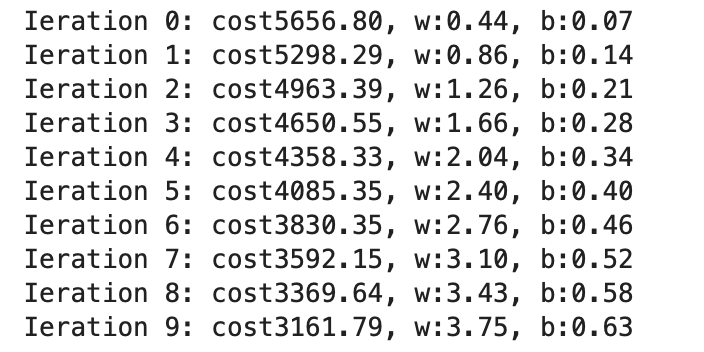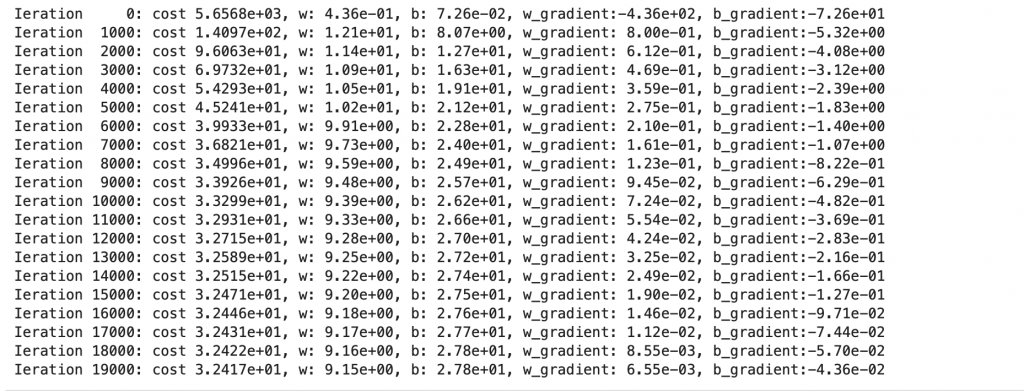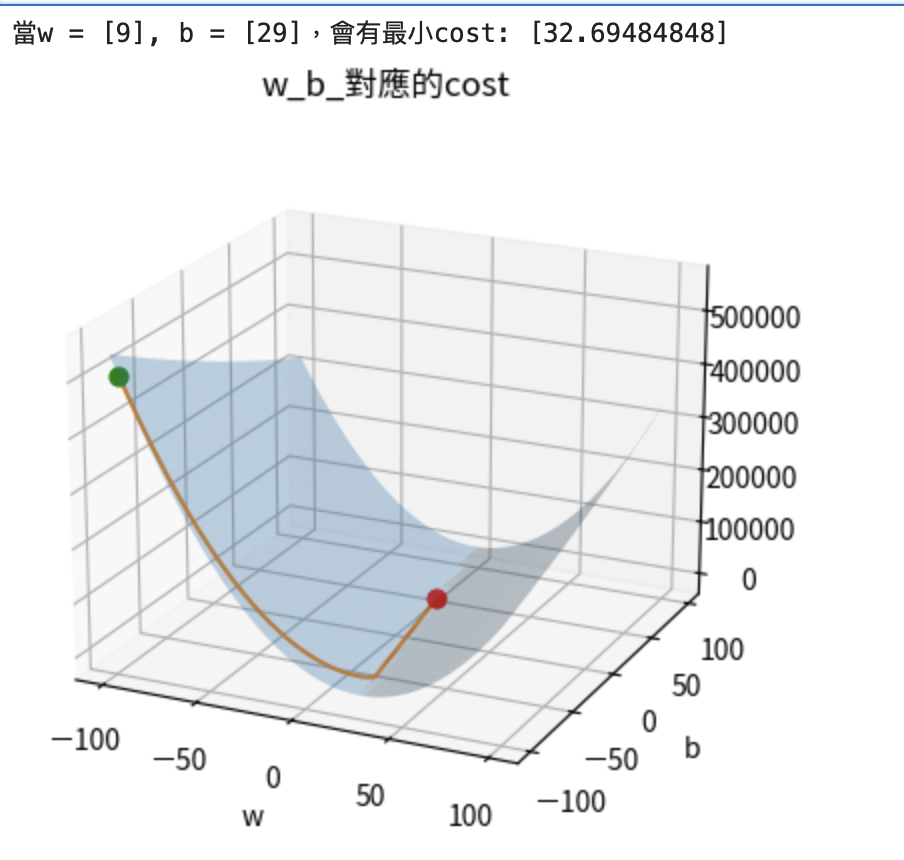import pandas as pd
url = "https://raw.githubusercontent.com/GrandmaCan/ML/main/Resgression/Salary_Data.csv"
data = pd.read_csv(url)
x = data["YearsExperience"]
y = data["Salary"]
def compute_cost(x, y, w, b):
y_pred = w*x + b
cost = (y - y_pred)**2
cost = cost.sum() / len(x)
return cost
def compute_gradient(x, y, w, b):
w_gradient = (2*x*(w*x+b - y)).mean() #對w微分後計算平均值
b_gradient = (2*(w*x+b - y)).mean() #對b微分後計算平均值
return w_gradient, b_gradient
w = 0
b = 0
learning_rate = 0.001
w_gradient, b_gradient = compute_gradient(x, y, w, b)
print(compute_gradient(x, y, w, b))
w = w - w_gradient*learning_rate
b = b - b_gradient*learning_rate
print(compute_gradient(x, y, w, b))
#輸出:
6040.596363636363
5286.0782714844245
=>執行10次
w = 0
b = 0
learning_rate = 0.001
for i in range(10):
w_gradient, b_gradient = compute_gradient(x, y, w, b)
w = w - w_gradient*learning_rate
b = b - b_gradient*learning_rate
cost = compute_cost(x, y, w, b)
print(f"Ieration {i}: cost{cost}, w:{w:.2f}, b:{b:.2f}")

=>執行10000次,每1000次print一次結果
w = 0
b = 0
learning_rate = 0.001
for i in range(10000):
w_gradient, b_gradient = compute_gradient(x, y, w, b)
w = w - w_gradient*learning_rate
b = b - b_gradient*learning_rate
cost = compute_cost(x, y, w, b)
if i%1000 == 0:
print(f"Ieration {i:5}: cost{cost: .2e}, w:{w: .2e}, b:{b: .2e}, w_gradient:{w_gradient: .2e}, b_gradient:{b_gradient: .2e}")

(可以看到cost依舊有在下降,但幅度有越來越小的趨勢,斜率gradient越來越接近0)
=>寫成函式:
def gradient_descent(x, y, w_init, b_init, learning_rate, cost_function, gradient_function, run_iter, p_iter=1000):
c_hist = []
w_hist = []
b_hist = []
w = w_init
b = b_init
for i in range(run_iter ):
w_gradient, b_gradient = gradient_function (x, y, w, b)
w = w - w_gradient*learning_rate
b = b - b_gradient*learning_rate
cost = cost_function(x, y, w, b)
w_hist.append(w)
b_hist.append(b)
c_hist.append(cost)
if i%p_iter == 0:
print(f"Ieration {i:5}: cost{cost: .4e}, w:{w: .2e}, b:{b: .2e}, w_gradient:{w_gradient: .2e}, b_gradient:{b_gradient: .2e}")
return w, b, w_hist, b_hist, c_hist
執行看看:
w_init = 0
b_init = 0
learning_rate = 1.0e-3
run_iter = 20000
w_final, b_final, w_hist, b_hist, c_hist = gradient_descent(x, y, w_init, b_init, learning_rate, compute_cost, compute_gradient, run_iter)

圖示:
import matplotlib.pyplot as plt
import numpy as np
plt.plot(np.arange(0, 20000), c_hist)
plt.title("itertion vs cost")
plt.xlabel("itertion")
plt.ylabel("cost")
plt.show()
=>設定不同初始點,gradient descend的路徑:
w_init = -100
b_init = -100
learning_rate = 1.0e-3
run_iter = 20000
w_final, b_final, w_hist, b_hist, c_hist = gradient_descent(x, y, w_init, b_init, learning_rate, compute_cost, compute_gradient, run_iter)
w_index, b_index = np.where(costs == np.min(costs))
print(f"當w = {ws[w_index]}, b = {bs[b_index]},會有最小cost: {costs[w_index, b_index]}")
ax = plt.axes(projection = "3d")
ax.view_init(20, - 65)
plt.figure(figsize = (7,7))
b_grid, w_grid = np.meshgrid(bs, ws)
ax.plot_surface(w_grid, b_grid, costs, alpha = 0.3)
ax.scatter(ws[w_index], bs[b_index], costs[w_index, b_index], color = "red", s = 40)
ax.scatter(w_hist[0], b_hist[0], c_hist[0], color = "green", s = 40)
ax.plot(w_hist, b_hist, c_hist)
ax.set_title("w_b_對應的cost")
ax.set_xlabel("w")
ax.set_ylabel("b")
plt.show()

學習資料來源:GrandmaCan -我阿嬤都會
機器學習的過程:準備資料=>設定模型=>設定cost function=>設定optimizer
